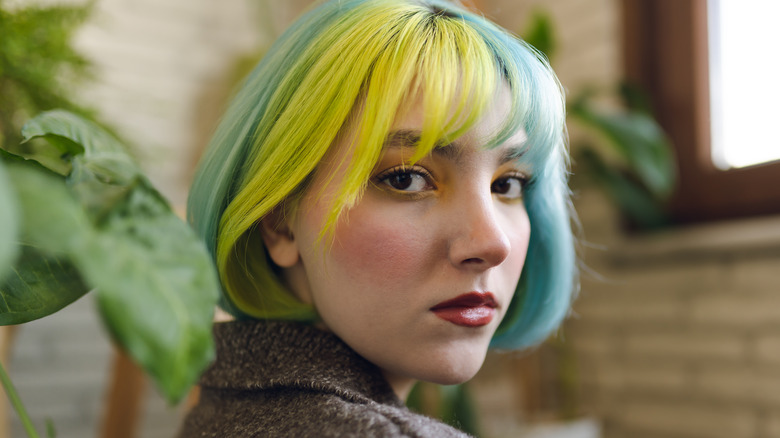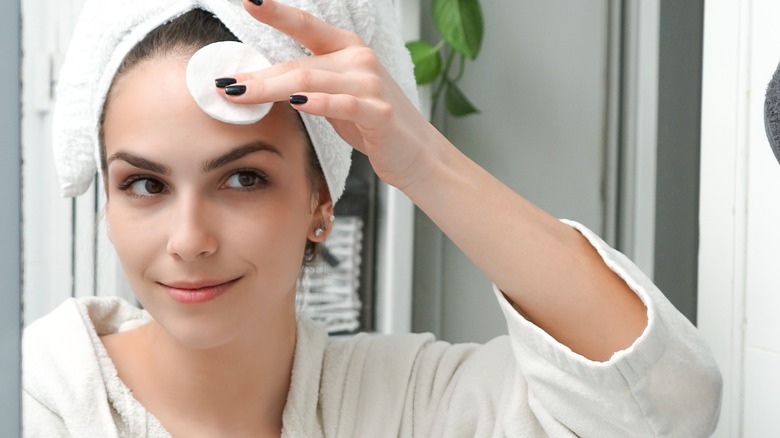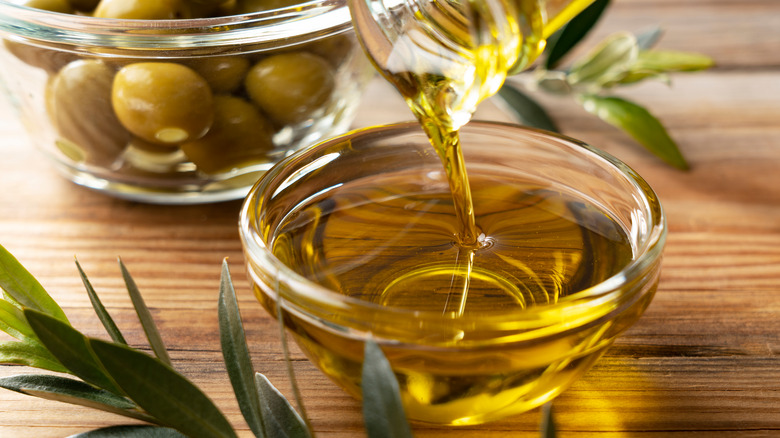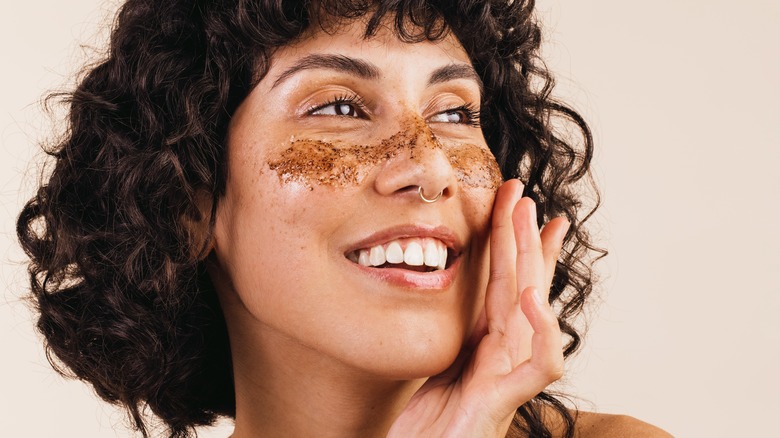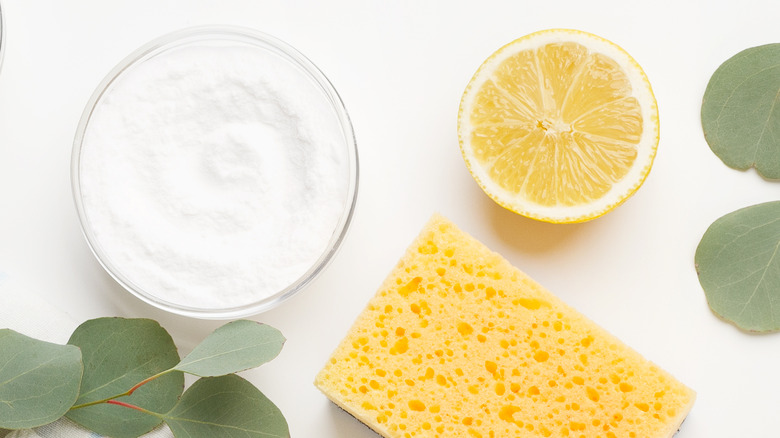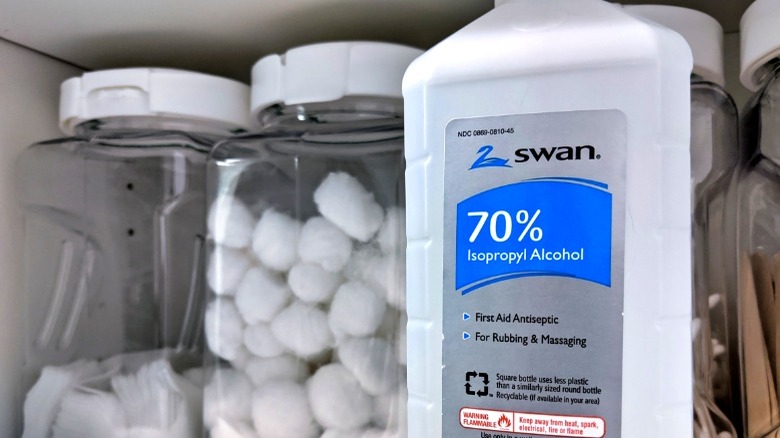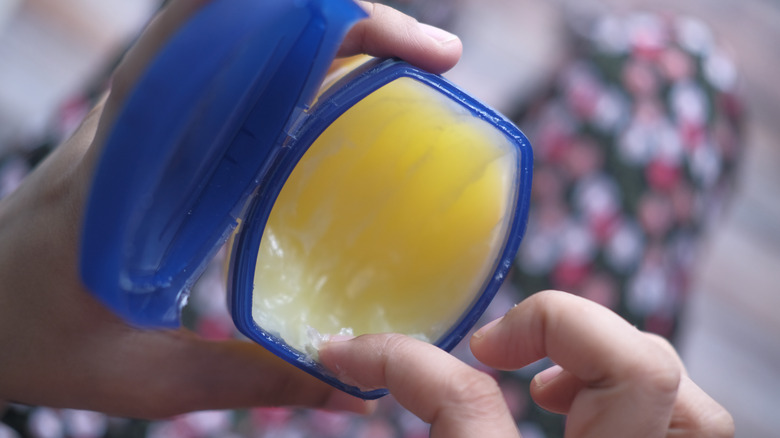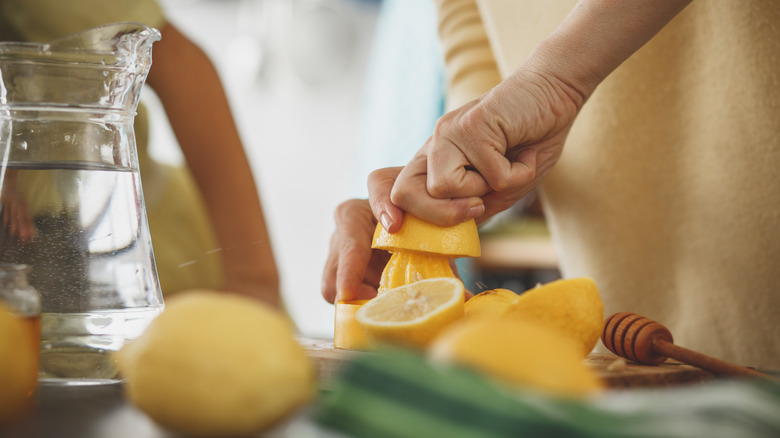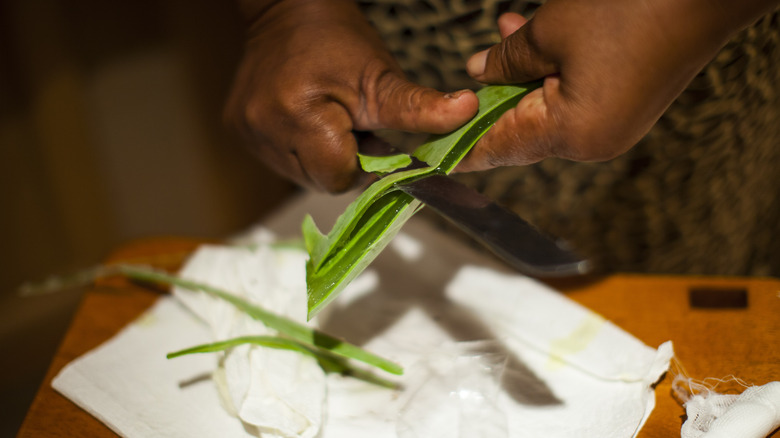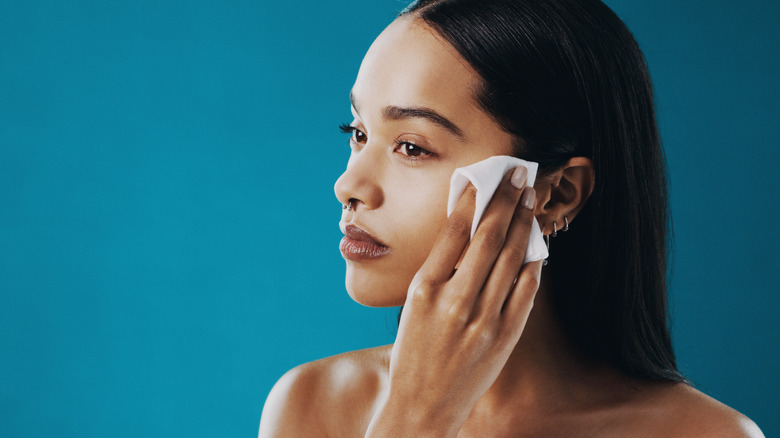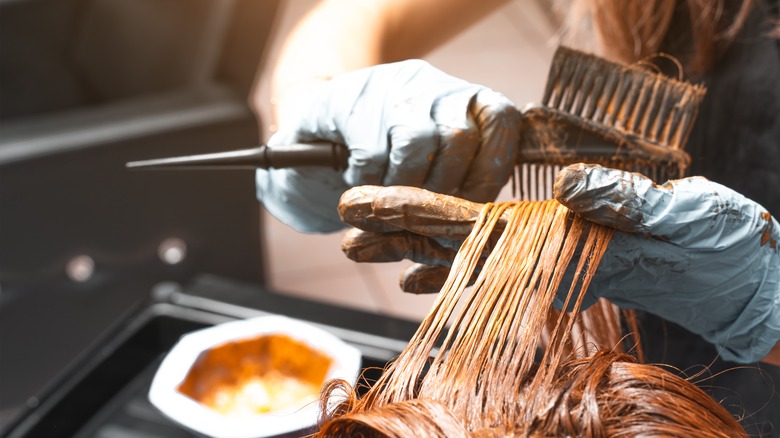12 Foolproof Ways To Remove Hair Dye From Your Skin
We've all been there. You visit your hair stylist to refresh your look with some chic balayage or foils, or maybe ask a friend to come help you apply a gorgeous box of copper-colored hair dye at home. Everything is going well, your mane looks fabulous, and the color is perfect. But no matter how careful you've been, a bit of that color ends up painting your skin instead of your hair. Now, you've got an amazing new 'do, but you've also got a distracting smear across your forehead that doesn't want to come off.
"The pigment in hair dye is designed to penetrate through the outer cuticle of the hair and remain there, infusing long-lasting color into the hair shaft. If exposed to the skin, it can also penetrate through its outer layer, causing a semi-permanent tint," dermatologist Joshua Zeichner, M.D., tells Good Housekeeping. To make matters worse, certain skin types are extra susceptible to staining and, potentially, irritation from hair dye. "While all skin types are equally at risk for dye staining, if you are using topical retinoids or products like alpha- or beta-hydroxy acids, the skin may be more prone to irritation from the dye because it will more easily penetrate the exfoliated skin."
Long story short, it's not uncommon to end up with a tinge of your tresses' new color on your skin, especially around your hairline, ears, and neck. But no one wants to go out with a sloppy dye job. So how can you clean up any excess dye that made its way onto your skin? Try these hair dye removal tips to help return your epidermis to its normal hue.
Cleanser or makeup remover
When you're trying to clear away hair dye stains without damaging your precious skin, you want to start with the most skin-friendly options first — for instance, your normal cleanser, makeup remover, or micellar water. Since you already use these products all the time, you should hopefully know that they're compatible with your unique skin type and sensitivity.
Of course, hair dye can be stubborn, so it may take a few rinse-and-repeat cycles to vanish that stain completely with a regular cleanser. However, if you're still seeing no progress after cleansing two or three times, you may need to move on to another tactic. As for makeup remover or micellar water, you can either rub the stain gently with a makeup wipe or use a cotton ball to apply remover to the stain and leave it for five minutes before rinsing (via Medical News Today).
Skin-safe oils
Recently, oil cleansing has been all the rage, and this trick may also be an effective way to get rid of excess hair dye on your skin. It works like this: due to its molecular structure, oil loves to bond with dirt, impurities, and other oils on your skin (via WebMD). Then, when you wipe the oil off, it takes all those contaminants away with it. Hair dye is no exception, and because natural oils are gentle even on sensitive skin, this method of dye removal is one of the safer ones to try.
First, choose a skin-safe oil such as olive, coconut, argan, almond, or even baby oil, and apply it to the stain. If the dye doesn't easily wipe away, leave the oil on for an extended period of time, such as overnight while you're sleeping. Just be sure to cover the area with a bandage or plastic bag so you don't get oil all over your sheets!
Gentle exfoliation
Because hair dye likes to sink into the layers of your skin, gentle exfoliation to remove the top layer of dead skin cells may help erase that dye stain. Note, the key word here is gentle — you don't want to scrub too harshly, or you risk rubbing away healthy layers and exposing the vulnerable skin underneath too soon. Over-exfoliation can not only cause redness and irritation but can also contribute to issues like breakouts (via the American Academy of Dermatology).
Begin with a mild face scrub or chemical exfoliant that you're accustomed to using. Then, apply it as normal, without leaving the exfoliant on for an extra long time or putting in any additional elbow grease. Remember, you don't want to overdo it; getting that dye off won't help much if you've left an angry red patch in its place. Struggling with noticeable dye stains on your scalp, such as along your part? Scalp scrubs are also the ideal way to handle the situation without disrupting that fresh new color on your strands.
Dish soap and baking soda
Hair dye can be a bit of a wild child, and it doesn't always restrain itself to your hairline. Sometimes, you may find stubborn smears of dye on your neck, shoulders, or back. And if you forgot to wear gloves while applying dye yourself, your hands and wrists probably look like a crime scene. So what is a good way to remove dye from non-facial stretches of skin?
Fortunately, in any area with more robust skin like your hands, a potent combo of dish soap and baking soda can help break up that lingering stain. While the baking soda provides natural exfoliation, the dish soap works to dissolve the hair dye (via Healthline). Simply mix the two into a paste, rub the mixture into your skin like you would normally lather hand soap, then rinse off thoroughly. Afterward, consider applying a moisturizing lotion or hand cream to restore hydration in the skin.
Rubbing alcohol
Dealing with hair dye stains that just won't quit? As a last resort — the nuclear option, if you will — you can go after that dye with rubbing alcohol, nail polish remover, hand sanitizer, or hydrogen peroxide that's below a concentration of 3%. Choose your weapon and soak a cotton ball with it, dabbing onto the dyed area of the skin.
However, these hardcore methods aren't recommended for the delicate skin of your face, which is more prone to irritation and adverse reactions to strong cleansers. As noted in a 2019 study on skin sensitivity published in Frontiers in Medicine, "The face has demonstrated to be the most common site of skin sensitivity ... due to the larger and multiple number of products used on the face (particularly in women), a thinner barrier in facial skin, and a greater density of nerve endings." So, when it comes to battling hair dye, reserve high-powered cleaning methods like rubbing alcohol to areas of tougher skin, like your hands.
Petroleum jelly
A tub of Vaseline should be a staple in everyone's beauty closet since it comes in handy in plenty of emergency situations. In fact, one of them is removing hair dye from your skin, and since petroleum jelly is skin-safe, you can use it on any area. All you have to do is put a layer of it over the dyed skin and let it sit for a bit, though you should note that the older the stain, the more time it generally takes for the Vaseline to do its magic. "The petroleum jelly will absorb most of the dye, and then you can wipe it away," dermatologist Nava Greenfield explains to Byrdie.
If you notice that the stains are stubborn, repeat the process and make sure you gently massage the petroleum jelly into the stains. And here's a little tip to make the process even smoother: Warm up the petroleum jelly a bit before applying it. Of course, make sure you don't burn yourself, but a slightly warmer temperature can help it work its magic even better. So, go ahead and give it a little zap in the microwave or simply rub it between your hands to warm it up.
Cow's milk
An unexpected hero from your fridge that you might be surprised to hear can also help remove hair dye stains is milk. Yup, cow's milk will do the trick in a pinch, and the best part is that it is so gentle it's also an excellent choice for anyone with sensitive skin. "Submerge a cotton wool ball in milk, squeeze out any excess, and rub it on the affected area," senior colorist Seniz Alka tells Stylist. "Dairy-free alternatives do not work — choose full-fat milk."
The combination of proteins and fats in the milk help break down the stain, and after five to 10 minutes of having the milk on the area, you will notice just how easily it will come off. Gently rub the milk off with a wet cloth and wash the area with a face or body cleanser. Of course, since milk is safe to put on your skin, you can also repeat this process as needed.
Lemon juice
When life gives you hair dye stains, reach for a lemon! Yes, the citrus fruit is not only a summer staple but can also help you tackle those stubborn dye stains on your skin. Thanks to its natural acidity, lemon works as a natural bleaching agent, and it actually helps break down the dye pigments and fade those pesky stains away.
For this method, squeeze fresh or bottled lemon juice into a small bowl, and dip a cotton ball into it. Gently dab the juice-soaked cotton ball onto the stained areas of your skin and let the lemon juice sit for about five to 10 minutes. Keep in mind that lemon juice is rather drying to the skin, so you don't want to leave it on for too long. Rinse the area with warm water, and don't forget to follow up with a gentle cleanser and moisturizer to replenish your skin's moisture barrier. We don't recommend this method if you have sensitive skin since lemon juice can be too harsh. Apart from that, be careful to use lemon juice on your face — you don't want to use it close to your eyes.
Toothpaste
It turns out that a bathroom staple can also come to the rescue when it comes to removing hair dye stains from your skin. That's right: Toothpaste isn't just for your pearly whites anymore — you can actually use it to remove hair dye stains from your skin.
So, how does toothpaste actually help? Well, it's all thanks to its mild abrasive properties and cleansing agents. To use toothpaste for dye removal, start by choosing a non-gel, white toothpaste. The non-gel variety tends to have more abrasive properties that are beneficial for this purpose. Squeeze a small amount of toothpaste onto your fingertips or a soft cloth and massage it onto the stained areas of your skin using small circular motions. The toothpaste helps to exfoliate the top layer of skin, gradually lifting away the dye stains. If the stain is persistent, you can leave the toothpaste on for a few minutes to allow it to work its magic.
You might experience a slight tingling sensation, but that's just the toothpaste doing its job. Afterward, rinse off the toothpaste with warm water. Still, keep in mind that those with sensitive skin could get irritated by leaving toothpaste on their skin for too long.
Aloe vera
While not all hair dye stain removal methods are suited for those with sensitive skin, aloe vera is known to be soothing and mild, which is why it's the perfect choice for those who worry that options like lemon juice or rubbing alcohol are too harsh.
Thanks to its gel-like substance and the fact that it is packed with vitamins, enzymes, and minerals, aloe vera can not only help remove skin stains but also heal and hydrate your skin. To use aloe vera for dye removal, start by obtaining fresh aloe vera gel. You can either squeeze the gel directly from an aloe vera leaf or use store-bought aloe vera gel without any added ingredients. Apply a generous amount of aloe vera gel onto the stained areas of your skin. Gently massage it into your skin, allowing the gel to penetrate. The cool and soothing sensation of aloe vera will provide instant relief to any discomfort caused by the dye. After 10 to 15 minutes, rinse off the gel with lukewarm water. You can use a soft cloth to gently massage and exfoliate the area, and the stain should come off easily.
Hair color wipes/solution
DIY remedies are great, but let's face it — sometimes you just need a targeted solution that gets the job done efficiently. Luckily, hair dye stain-removing products on the market tackle those pesky stains, making them a convenient and effective choice.
Hair color-removing wipes or solutions are game-changers when it comes to battling stubborn dye stains. These products contain ingredients that help break down the dye pigments and gently lift them away from the skin without causing any irritation or discomfort. To ensure you get the best results, following the instructions on the product is essential. If you are someone who regularly dyes their own hair at home, investing in a professional stain-removing product is a smart move. With a professional-grade hair color removal solution in your beauty arsenal, you will never have to worry about walking around with stained skin again. You can thank us later.
Visit a salon for removal
Sometimes, when it comes to hair dye stains on the skin, you may need professional help, which is why visiting a hair salon is the best option. While DIY methods can work, depending on the size and intensity of the stain and the area where it's located, going to a professional will ensure the stain is gone and your skin isn't damaged.
Since they have dealt with many hair dye stains over the years, salon experts have extensive knowledge of this problem. Apart from that, they are also equipped with the right techniques and products to tackle the stains, which you often don't have. Professionals at the salon will assess the extent of the staining and tailor the treatment accordingly, providing personalized care for your specific needs. And, yes, you will have to pay for the removal, but having a professional do it allows you to relax and enjoy the pampering experience, giving you the peace of mind that the stain will be effectively and safely removed.
How to prevent hair dye from staining your skin
While you can remove hair dye stains from your skin, preventing them is so much better. By taking a few simple precautionary steps, you can easily minimize the risk of dye transferring onto your skin during the coloring process. First and foremost, it's crucial to create a protective barrier between the hair dye and your skin. Applying a thin layer of petroleum jelly or a barrier cream along your hairline, ears, and any exposed areas of your neck can act as a shield, preventing the dye from adhering to your skin. Ensure that you apply the barrier product generously and evenly, that way once you wipe any hair dye off, your skin will be stain free.
Furthermore, being careful and precise when dying your hair can significantly reduce the chances of the dye reaching your skin. Make sure you apply the dye to your hair in small sections so that you minimize the chances of it coming into contact with your skin. Pay special attention to your hairline, where dye transfer is more likely to occur. Wearing protective clothing, such as an old button-down, can also prevent the dye from staining your skin.
Finally, the most important tip we can give you is to never rush — always make sure you have plenty of time to dye your hair so you can be extra careful. Also, always ensure you always have a damp cloth or wipes at hand. After all, the sooner you remove any dye from your skin, the less noticeable the stain will be.
